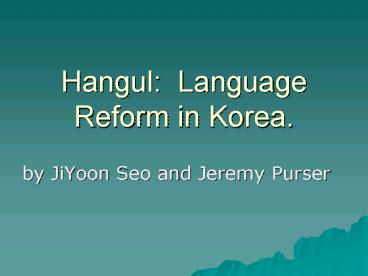Hangul: Language Reform in Korea. - PowerPoint PPT Presentation
1 / 14
Title:
Hangul: Language Reform in Korea.
Description:
written Korean Hangul (Korean alphabet), Hanja (Chinese symbols) Hangul ??. phonemic alphabet ... Hangul was greatly influenced by Chinese artistically. ... – PowerPoint PPT presentation
Number of Views:2561
Avg rating:5.0/5.0
Title: Hangul: Language Reform in Korea.
1
Hangul Language Reform in Korea.
- by JiYoon Seo and Jeremy Purser
2
Korean
- official language of North and South Korea
- 78 million speakers worldwide
- large groups in former Soviet Union, Australia,
the United States, Canada, China, Brazil, Japan,
and the Philippines
3
Korean
- Unclassified perhaps Altaic or a language
isolate - spoken Korean Hangugo
- written Korean Hangul (Korean alphabet), Hanja
(Chinese symbols)
4
Hangul ??
- phonemic alphabet
- 24 Hangul letters (Jamo ?? )
- Ja means character and Mo means mother.
- organized into syllabic blocks
- referred to as Chosongul ??? in North Korea
5
Hangul ??
- Hangul was greatly influenced by Chinese
artistically. - Such a practice in English would produce the
following examples - that ? t a oven ? o e
- /h t v n
- living ? i
- i n
- l v g
6
Introduction of Hangul
- Hangul became the written language of Korea when
schools reopened in October 1945. - Hangul had been prohibited by Japanese law since
1938. - Korean scholars felt that Hangul was only
suitable for women.
7
Introduction of Hangul
- Large groups within the National Committee on
Education favored used of Japanese or Chinese. - There was an aesthetic beauty seen in Chinese
characters due to its association with Buddhism
and Confucian philosophy.
8
Arguments for Hangul
- Hangul is intrinsically Korean.
- It was a symbol of cultural heritage and
progressive change. - It was advocated by scholars that had carefully
studied the language. - It was opportunity to gain mass literacy.
9
Progress
- Members of the Korean Language Society were
imprisoned for creating a standard Hangul
dictionary because such work had been forbidden
by the Japanese. - Hangul did not develop along with industrial
changes of the world.
10
Progress
- Hangul was promoted by King Sejong, the fourth
king of the Joseon dynasty. - Sejong believed a new script was necessary
because of the differences between Korean and
Chinese.
11
Suppression
- The tenth king, Yon San, saw a poster criticizing
his actions. Thus, he decided learning is a
dangerous thing. - Yon San attempted to suppress the language
through ridicule. However, Hangul had become too
useful to forget.
12
19th 20th Century
- 1894 Hangul was adopted for the first time in
official documents. - 1910 Korea was annexed by Japan and Hangul was
banned. - 1930s Hangul was standardized under Japanese
occupation. - 1940 A system for expressing other
orthographies in Hangul was published. - 1945 Korea gained independence from Japan.
13
Conclusions
- Hangul experienced resistance due to presence of
the Japanese and scholars that considered the new
alphabet to be vulgar. - Hangul proved to be an incredibly useful and
efficient alphabet thus, it was difficult to
suppress.
14
Bibliography
- Anderson, Paul S. Korean Language Reform. The
Modern Language Journal. 32 (1948) 508-511. - Hsiang, P.S. What is the Korean Language? The
Modern Language Journal. 34 (1950) 441-443. - De Mente, Boye. Korean in Plain English.
Chicago Passport Books. 1988. - Sangbaek, Lee. The Origin of the Korean
Alphabet. Seoul Tong-mun Kwan, 1957. - TourNetKorea. Lets Learn Korean. 2000.
- Wikipedia. Hangul. 22 April, 2006
- Zkorean. History of Hangul. 1987.

